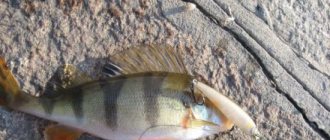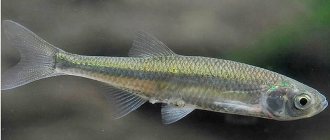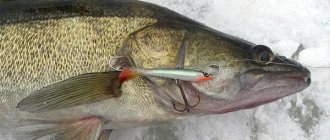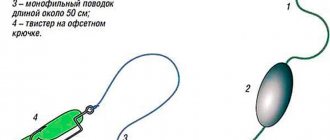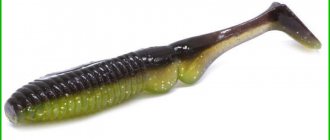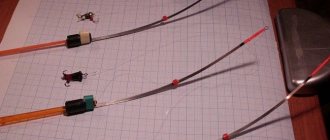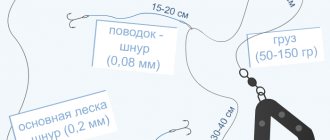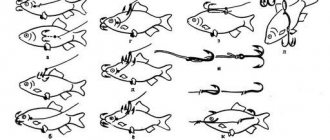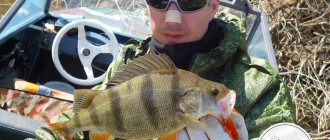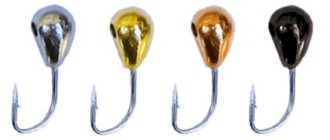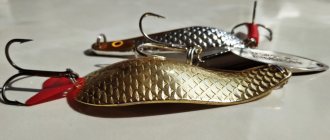Alexey Falaleev | June 4, 2021
Catching perch with fry – it couldn’t be simpler. This fishing mainly takes place from the shore. You can catch perch with fry from a boat. A little more labor-intensive, but there is a wider selection of places suitable for fishing. At the same time, the fishing itself remains as simple and sincere. Let's look at all these options in more detail.
First of all, I will tell you about my practice - a small but, as it seems to me, important introduction to the topic. In the modern world, adjustments and improvements are made to existing fishing methods every year.
I won’t say that the principles of fishing themselves are changing, no, but some new technical approaches to equipment are constantly being sought. As a result, a fan of feeder fishing goes to a pond, having with him a couple of feeders/pickers, several types of the latest baits, a separate set of flavors and a bunch of feeders of different sizes and configurations, not to mention all sorts of auxiliary accessories.
In addition to various types of spinning rods, a modern spinning angler carries with him a bunch of boxes of bait, hoping that on the spot he will be able to decide which combination will work that day. Even a floater comes to the shore with several rods for different purposes - a “swing” there, a “laptop”, etc., various equipment and a bunch of fishing devices.
These are the realities of the modern fishing world, although quite recently a bottom fishing enthusiast made do with one universal rod and a couple of equipment while fishing, a spinning angler had enough of a box with a dozen of his favorite spinners, and a floater went to a pond with only a light bamboo fishing rod and a jar of worms.
Of course, there is nothing wrong with the comprehensive modernization of fishing equipment, but... But sometimes you want to turn fishing from a constant competition with whom and why into a relaxing holiday, simple and uncomplicated. It seems to me that many anglers eventually come to the same conclusion.
I’m a fan of live bait fishing, and if I want to fish as simply as possible, I go out fishing for perch. You can fish with a “float” using fry throughout the entire period of open water. Traditionally, it is considered more productive to do this in the fall, but I had excellent results in late spring and throughout the summer.
Tackle construction concept
To catch perch with fry from the shore, I use a telescopic fishing rod 4 - 5 m long with a small wire reel - a basic fishing line storage (photo 1) .
The standard equipment includes few elements. This is a float with a noticeable antenna and with such a carrying capacity that live bait cannot sink it (just weigh the medium-sized fry you prepared on an electronic kitchen scale and throw a couple of grams on top).
Then - a fishing line of 0.14 - 0.18 mm, a sinker-pellet (if you need to adjust the full immersion of the float body), a hook to the size of the perch that presumably lives in a particular body of water. As you can see, there are no bells and whistles here, the whole point is in a certain approach to such fishing. For me, this is running, search fishing. I usually go to small forest rivers. There is some kind of natural attractiveness in them, or something. Occasionally I go out to larger rivers, and sometimes to ponds and lakes.
It is not difficult to obtain fry for bait. I remember when I was a child, my brother and I begged my mother for a piece of old tulle for curtains, tied it to two sticks - and with this clumsy little thing we successfully caught small fish in the nearest stream. Actually, even after many years that have passed since then, our approach to catching small fish has not changed significantly (photo 2) .
What, where and when to lure perch
There is nothing complicated in the fishing technique using natural baits. Catching "minke whales" with live bait is done after they swallow the bait placed on the hook. It is advisable to fish for perches using those inhabitants of the underwater world that live with predators in the same water area. These can be small crucian carp, roach, minnows, minnows, verkhovkas, bleaks.
If you try to catch the desired trophy with live bait, which is not in the river, lake, or pond, the “humpback whale” can completely ignore it, and if it pecks, it will be weak. Only habitual food will force the predator to actively swallow the bait.
You should not get carried away with catching exotic live bait, even if they have proven themselves excellent in other places. But this predator will almost always be tempted by crucian carp.
In places for hunting, perch chooses clean areas of the water area, hiding in thickets and snags. Depending on the time of year, it can live at different depths. Medium-sized individuals like to live in backwaters with dense underwater vegetation, and only in the autumn do they come to open areas. Large “humpback whales” live in the depths, appearing on the surface only in the morning and before sunset. As a rule, “minke whales” stay in the same areas and rarely leave them.
In ponds and lakes with stagnant and muddy water, perch chooses unpolluted places near bottom plants. In rivers it also prefers thickets or areas with a not too fast flow near snags, boulders, logs and stones.
To learn more:
Twister bait: the subtleties of fishing for perch and pike
Perch using live bait in the spring, summer months and fall is caught almost equally. This fish goes hunting at dawn and stops feeding after sunset. She doesn't bite at night. The most convenient time for catching is early morning on a cool day. The predator shows its activity by chasing schools of other fish. The process is clearly visible close to the coast in the warm season. The presence of “humpback whales” is determined by the fry’s jumping out of the water.
Catching perch with live bait in winter is a little different from fishing in summer and autumn. During the frosty season, “minke whales” roam throughout the reservoir, looking for deep areas. They break up into small flocks, and a fisherman who has caught 5-6 individuals in a row urgently needs to change the fishing location.
Best fishing spots
Having stocked up on the fry (photo 3) , we begin to search for perch. What places should you pay attention to?
The surest step is to find an obvious bay where the main flow of the river is not felt (photo 4) . Fish often hang around here in huge quantities. This is understandable: small fish escape from a strong current, larger fish prey on small fish or come to rest. The best option is the presence of aquatic vegetation in such a bay: by throwing the tackle to its edge, you can count on a good bite of fish, including perch.
The perch bite is expressive. The float either dives under the water or, crouching slightly, begins to move to the side. There is no point in delaying the hooking, because the fry is scurrying in front of the striped fish - its natural food supply, so it will not bite and suck it, like, for example, a worm, but, most likely, will try to eat it in one throw (photo 5) . It often happens that, having missed, the perch simply knocks the bait off the hook, so the supply of fry should be significant.
By the way, if you notice a bite or obvious movement of the float, but wait a while before hooking, and then the water calms down, it’s better to check your fry. It could very well be that the striped one knocked him down.
Another promising place is the area just below the tree that fell into the water, where the current is calmer and there is depth (photo 6) . The predator loves such places very much. Here you should definitely try fishing, but all your actions must be careful, i.e. You need to approach quietly, cast without noise, and do not make sudden movements during the fishing process. In this case, there is a real opportunity to catch a dozen or two “minke whales” from one place before they become wary or leave this area for a while.
Often the perch hangs around the remains of bridges and crossings (photo 7) .
If you find such structures on your way, be sure to stop here. It is clear that the depth here is quite large (it’s not for nothing that a bridge was once built), so it is attractive for the largest perches. However, near destroyed buildings you often find a large amount of rubbish under water, parts of the same crossings, so don’t be surprised by your fishing rod getting snagged. And in order not to scare the fish in case of a serious hook, I simply break off the line. It is easier to attach a new hook than to fiddle with unhooking the hook and then wait for the fish, frightened by the noise, to return to their habitat.
Interesting from the point of view of fishing and the unevenness of the bottom. If you are familiar with the bottom topography or, say, notice a clear depression in the current (polarized glasses will help with this, especially in calm weather), then the right decision would be if you cast your fry a little upstream from this place. The float release should be set larger, according to estimates - equal to the depth that is in this pit. And let your equipment, carried away by the current, drag along the bottom, and when it reaches the hole, your fry will naturally find itself in front of the striped predators that are hovering near this dump in anticipation of prey. This nuance often helps out.
If the water is clear - and the fish is clearly afraid of you, then leave your rod on a stand or coastal bushes - and move a few meters away from it (photo . Often a few minutes are enough for the predator to calm down and make a lunge at your fry. Yes, when hooking and While fishing, you will probably scare away the rest of the flock, but if the place is worth it and you have some time to spare, then you can count on the next striped bite using this tactic.
. Often a few minutes are enough for the predator to calm down and make a lunge at your fry. Yes, when hooking and While fishing, you will probably scare away the rest of the flock, but if the place is worth it and you have some time to spare, then you can count on the next striped bite using this tactic.
By the way, in principle, it’s a good idea to have the simplest rod stands with you (photo 9) - they will make it easier to prepare the tackle and allow you to move away from the rod during the fishing process. But if you don’t have store-bought stands or you forgot them at home, you can cut flyer branches from the nearest bush, or it’s better to take dead wood.
And since during such fishing you sometimes move from one promising point to another over long distances, carry these flyers with you in a rod case (photo 10) - so as not to cut out new ones each time and cause minimal damage to nature.
Live bait bait methods
Before you properly hook a fish, you need to select the appropriate size of both the sting and the bait. If the tip is large, the baitfish will quickly die, and the small one will slip off. Dress the fish in several ways:
- The hook is hooked onto the tail, having previously wrapped this area of the baitfish with a thread made of nylon or nylon.
- Carefully pierce the area of the upper fin. In this case, you must be extremely careful not to damage the fish.
- The hook is passed through the mouth and out through the gills. This method is the simplest and most reliable.
To learn more:
Fluorocarbon pike leashes: the secret to successful fishing
The nuances of shore fishing for whitebait
I won’t dwell on the fact that in addition to perch, the fry may be interested in, for example, ide, chub, small pike perch or burbot. These cases are infrequent, one might say exclusive. And, in principle, their bites will not bring anything to the fishing picture except additional excitement. But I must say that a pike bite can be an interesting, but not always pleasant surprise.
Well, maybe not pike, but often small beetle (photo 11) . Why unpleasant? The probability is too high that, having encroached on your bait, the small bee will easily bite the fishing line, because, let me remind you, you are catching perch without using any additional leashes.
You can, of course, protect yourself in case of a toothy bite by adding a leash to the equipment, but, as verified, in this case the number of perch bites will be catastrophically reduced. Therefore, advice: it is better to have more spare hooks in your arsenal. As practice has shown, not every pike bite ends in a line being broken - it happens that the pike either clings to the edge of the lip, or simply does not have time to do it.
If the pike did not have time to bite through the fishing line, do not be lazy, unhooking the prey, tie the hook, removing the area of the already frayed fishing line. Yes, I note that biting even a small pike on a float rod is always a bright and memorable moment in the process of catching perch with fry, bringing new emotions of the fishing day.
As a rule, this creates a fair amount of noise, so once you catch a pike in one place, you can safely move on to the next. Even if a flock of striped ones was hanging around here, they would most likely leave this place when the toothy one approached. Wait for them to return or look for another fishing area - it’s up to you. Personally, I prefer to move more along the shore and look for new fishing spots.
One more touch. I move from place to place without putting down the rod only if I see this new promising place and make the transition along the open bank. If there is a small forest or bush on my way, I fold the fishing rod and put it in its case. Getting ready to fish is a matter of one minute, but moving with a spread-out rod through the forest, through the bushes, when every branch is trying to catch your fishing line, is still a pleasure.
Another nuance regarding the fry. It is best to catch it on sandbanks, where it strays to escape a predator waiting for prey in the depths. The best small fish when fishing for perch is a medium-sized minnow (photo 12) . Verkhovka, roach and medium-sized spruce perform well.
Some may find walking fishing tiresome. Not at all. If your route is planned correctly and you calculate your own strength, then even a long journey with stops in promising places will not be too difficult, but will also turn out to be interesting. It is not a fact that the fish from the shore will be caught very large (photo 13) - the main thing is that if you find an interesting point and do not make a fuss, it will bite actively, spectacularly and will bring a lot of positive impressions from its bites.
How to fish with a float rod
The best time for those who are interested in how to catch perch with live bait on a float rod is the summer and autumn, but in the spring the fishing process has a number of difficulties and does not always end successfully. For fishing, a fly rod is used, as well as a match rod, which allows you to cast into a reservoir at a distance of up to 20 meters.
When fishing with the first method, a reel is not used, but the equipment includes a drum for storing thread. In the second method, an inertia-free system is used, due to which the fisherman can cast several tens of meters.
Important! A fly rod is perfect for fishing in rivers, but in the autumn in small bodies of water it is better to give preference to a fly rod.
Catching perch with live bait using a float rod requires choosing the right place for fishing, and the best place will be one that is located close to snags or aquatic vegetation. It is worth remembering that perch is most found in places where there is a lot of oxygen. The fishing process itself is not complicated; you need to put live bait on the hook and then cast it.
Before casting, it is best to set the float depth to about a meter. It is worth remembering that small bites can be made by live bait. It is difficult to confuse it with a perch’s bite, since the latter’s bite is usually clear, namely, it takes the float under the water or to the side.
With a properly executed hook, he has no chance of getting off the hook. In general, it is recommended to have a carbon fiber fishing rod, since the pace of fishing is very rhythmic and requires frequent casts into the water.
Important! For fishing to be productive, the area should first be fed, for example, with ordinary bread crumbs. First of all, this place will arouse the interest of peaceful fish, but later perch will also approach the place.
Live bait fishing from a boat
If you decide to catch perch with fry on a large river, it makes sense to do it from a boat. When I fish on small rivers, I don’t always want to tinker with a boat, but if I have a vast area of a deep river in front of me, the use of a floating device is more than justified.
Schooling perch, especially closer to autumn, like to stay in fairly deep areas that are not always accessible to shore anglers. Promising places, as a rule, are visible to the naked eye: fallen trees, snags sticking out above the water, obvious pools (photo 14) .
The main difference between this kind of fishing is the search for places without current. Here the calculation is made on the fact that the perch, standing in an interesting place, eventually comes out of its hiding place - and attacks your fry. You do not catch the most active and hungry ones, as happens on micro rivers, moving from one place to another, but systematically replenish your catch from one promising point.
Naturally, during the day I move from one place to another, but I do this infrequently, still focusing on the long wait for fish in each. And this is justified. Even if you made a noise when you anchored or tied to a protruding tree, there is a high chance that the perch will calm down and begin to bite systematically.
When fishing from the shore, I mostly fish with one rod, putting out the second one only during moments of rest or lunch. With one fishing rod it is easier to move from place to place and easier to manage. When I'm on a boat, I usually put out two rods to increase the likelihood of a bite. It happens, however, that the perch bites very well - and then you have to put away one fishing rod.
As I already noted, when fishing on small rivers, I try to fish from the shore. But if there are no normal approaches to fishing points on a wild river, if its banks are continuous thickets of bushes or small forest (photo 15) , I get into the boat.
Yes, sometimes it can be difficult to raft due to the abundance of fallen trees or bushes hanging over the water, but even such difficulties are not noticed when you manage to float out to an interesting section of this river that is not visited by anglers. An obvious underwater blockage or an interesting bay often brings very interesting and worthy results.
Now to the question of choosing a swimming device. The undisputed leader here will be the PVC boat (photo 16) . And the most common option in our time, and quite mobile, and, importantly, completely silent.
As a last resort, you can use wooden boats (photo 17) . But as for the duralumin boat, from which I also fished, but much smaller, I can say with confidence that the perch is afraid of such boats. They are larger and more noticeable, and any knock in the boat is reflected in the water as a clear fright of the underwater inhabitants.
On metal boats it is good to go out into the Big Water, to a considerable depth and catch fish remotely using a spinning rod, but if you want delicate fishing for striped fish, there is no better PVC rowing boat. It was not by chance that I wrote the word “rowing”. Naturally, it is more convenient when you sail around interesting places on a motor, but again, as practice shows, it is better to swim (albeit on a motor) upstream and, turning off the engine and rowing, stop near interesting places and fish for them.
I agree, at the peak of perch activity, he may not pay much attention to the noise from the propeller and after some respite he may begin to get caught. But try to maintain silence - and, I assure you, the results of your fishing can please you very much.
Live bait fishing tactics
On the river it is good to fish from steep banks, moving along the current, throwing bait to snags and thickets. On large bodies of water, you can determine the location of the predator by observing the seagulls. Where they circle close to the water, there are fry, which means there are perch there.
A small fish emerging from the water in panic is a sign of the presence of a predator. Early in the morning, perches can gather close to the shore. The main thing here is not to scare off. You need to cast while away from the shore in order to remain unnoticed. Morning fog is the best camouflage.
Perches hunt in groups. Early in the morning, having noticed a lurking flock of fry, predators surround the flock of fry and attack. The water in that place is literally seething. It is a great luck for a fisherman to get to such a place and the catch will be huge. Small individuals usually hunt near the surface. Closer to the bottom, large humpback whales await their prey. To catch a trophy, you need to hook a heavier weight so that the bait sinks to the bottom.
Perch is a commercial fish. Its dietary meat is considered one of the most delicious. Striped fish soup with the addition of spices and mushrooms is the most exquisite dish. In addition, this species of predator is an object of sport fishing.
It is more difficult to catch than any other fish, and the most experienced fishermen can catch a worthy trophy. In our country, fishing competitions are held, the main fish being perch.
Time to catch
I’ll tell you about the most optimal time for catching perch with fry. As I wrote earlier, in this way you can catch striped fish during the entire period of open water, from spring to late autumn. But as for the greatest fishing efficiency during the day, I believe there are significant differences depending on the time of year.
At the end of spring and summer, until the second half of August, the morning and evening hours are the most productive, because it is then that the fish are most active. Especially at the beginning of summer, in June, you have to arrive at the reservoir while it is still dark in order to catch this activity (photo 18) .
The closer to autumn, the more the water cools, the longer the period of active perch fishing becomes - and it can be quite comfortably caught throughout the daylight hours. Maybe not so consistently, waiting for the peaks of his activity, but still quite successfully.
Catching perch with fry is spectacular, interesting and often very rewarding fishing. This is not sitting in one place waiting for a predator to approach. This is a search. Search for new promising places, new depths, reliefs and fishing conditions. It's actually exciting. Therefore, I advise every angler to try his hand at catching perch with fry.
I should note that while I periodically meet anglers who catch perch with a fishing rod using fry from boats, I have never come across those who hunt for striped fish from the shore using the search method. And this is amazing. After all, if people knew what pleasure they were denying themselves, they would certainly take a fishing rod, catch a small baitfish and rush to the shore for a perch.
Choosing fishing gear
Catching perch with live bait is impossible without using one of the following means:
- reliable float rod;
- well-balanced jig;
- high-quality bottom tackle;
- circles - zherlits.
Float equipment
The most popular equipment for this type of fishing is a float rod. To install the equipment, you will need a stick with an unsteady top to softly absorb the cuts. The fishing line should be 0.22-0.25 mm in diameter and green or neutral in color. It must be wound exclusively on a spinning reel.
To learn more:
How to make a girder for pike
The load must be selected in such a way that the live bait has a certain freedom, but at the same time cannot insert the equipment into snags or reeds. The float must be proportionate to the shipment (usually 5-10 g). Both for fishing from a boat and when fishing from the shore, sliding models are used. The rig requires hooks numbers 5-10 with a long shank, which are easier to remove from the mouths of voracious perches. It is advisable to refrain from using stings made of thickened wire - they injure live bait.
Throw the bait in a neat pendulum manner, so as not to stun the bait by hitting the surface of the water. When bitten, the perch will move the float with a sharp movement to the side, drowning it. It is necessary to hook immediately, since the predator swallows the bait on the move.
Using a jig
In calm water, experienced fishermen often use this type of equipment, adding live fry as additional bait. This type of tackle allows you to avoid snags in places where fishing on a float is accompanied by numerous breaks.
In the warm season, a vein of 0.17-0.22 mm is taken, and in winter the line should be even thinner, in the range of 0.13-0.14 mm. The fact is that in icy water even predatory fish are not very active, and the use of rough tackle can scare them away. In order for the catch to be effective, it is necessary to play with the jig both at the bottom and in different layers of water. The activity of the predator and its bite are monitored by a lateral nod.
Catching perch with bottom tackle
The equipment is used regardless of the time of year, but it becomes most effective in August-November, when the fish move to the depths. The popular classic donka is a tackle with a short rod, an inertia-free reel (an old Neva “drum”), a strong core, a weight and a leash with a hook (you can use several leaders, placing them above the lead weight).
The baited bottom must be cast smoothly so that the bait remains intact. With its help, they catch lonely snags, flooded bushes and other places where the float rod does not work due to the large number of hooks. Before hooking the prey, it is advisable to pause and even unwind a little of the vein. The perch swallows the prey in motion, and when it feels resistance, it can throw the bait.
To learn more:
Review of baits for catching carp in October
Zherlitsy and mugs
The equipment is almost no different from those used to catch pike, except in size. For installation you will need:
- main line with a diameter of 0.3 mm;
- reliable leash 0.2 mm thick;
- light lead weight;
- a hook that matches the size of the bait fish.
The bait is set at the expected depths of habitat for a school of perches. In late spring and summer - at half-water, the rest of the time - deeper. To make fishing more catchy, you need to install 3-4 girders in a circle, and pour small bait into the center between them. A peaceful fish will soon approach the spot, and predators will follow.
More about live bait
The best live bait for perch is young crucian carp, roach, verkhovka, gudgeon, bleak, minnow and fry of the predator itself.
How to get
The easiest way to purchase fry is in specialized stores, but catching live bait for perch is a simple process. In some places not far from the shore, use a jar or bucket to scoop up water closer to the bottom - and a catch of 1-3 fry in your hands.
However, experienced fishermen always have a small fish in their arsenal. First, complementary food is poured onto the installation site of the device and placed so that it does not get carried away by the current. After a few minutes, the little fish are raised, and all the small fish that were above the net at that time fall into the trap.
Storage and transportation
To keep the fish alive during transportation to the fishing site, it is necessary to maintain a constant water temperature and oxygen saturation.
For storage and transportation, it is best to use a 10-liter bucket with a lid, in which you need to constantly change the water. If the fry begins to rise to the surface and gasp for air, it’s time to change the water; there is no oxygen left in the old one.
During transportation, the container is filled to the very brim and tightly closed, ensuring high stability and minimal vibration.
How to plant
The main rule for baiting bait is that the hook matches the size of the bait. A large one will lead to severe damage and death of the fry, and a small one will easily jump off.
There are three ways to rig live bait:
- by the tail by pre-winding it with nylon or nylon thread and then attaching a hook;
- behind the back, threading the hook through the skin next to the upper fin. This should be done carefully so as not to damage the spine and destroy the bait;
- behind the head, passing the point of the hook through the nostrils or lip and bringing it out through the gills.
